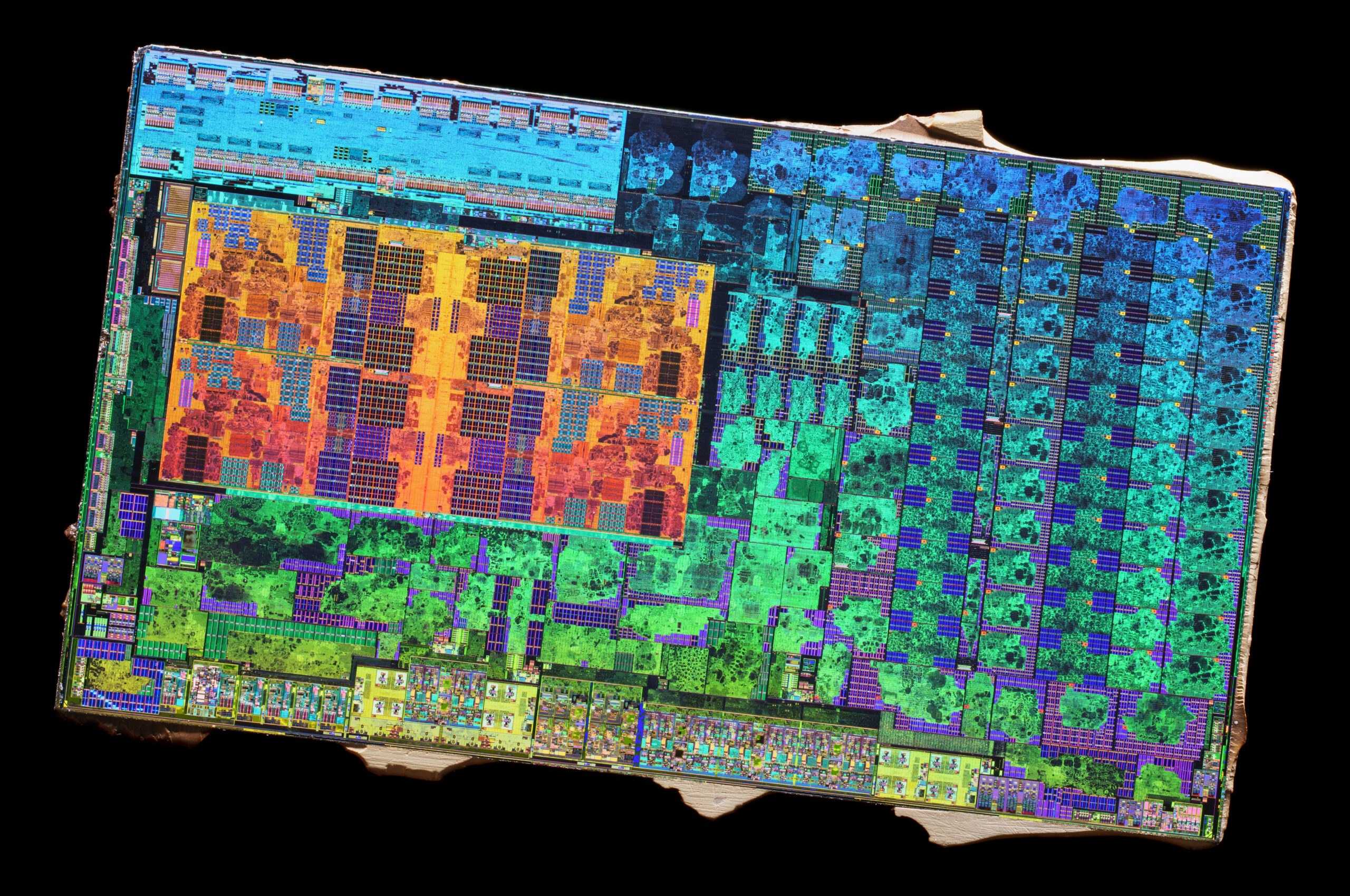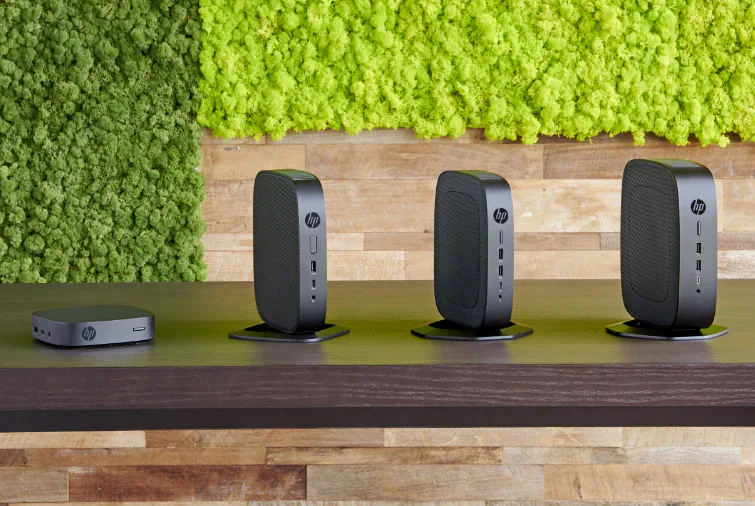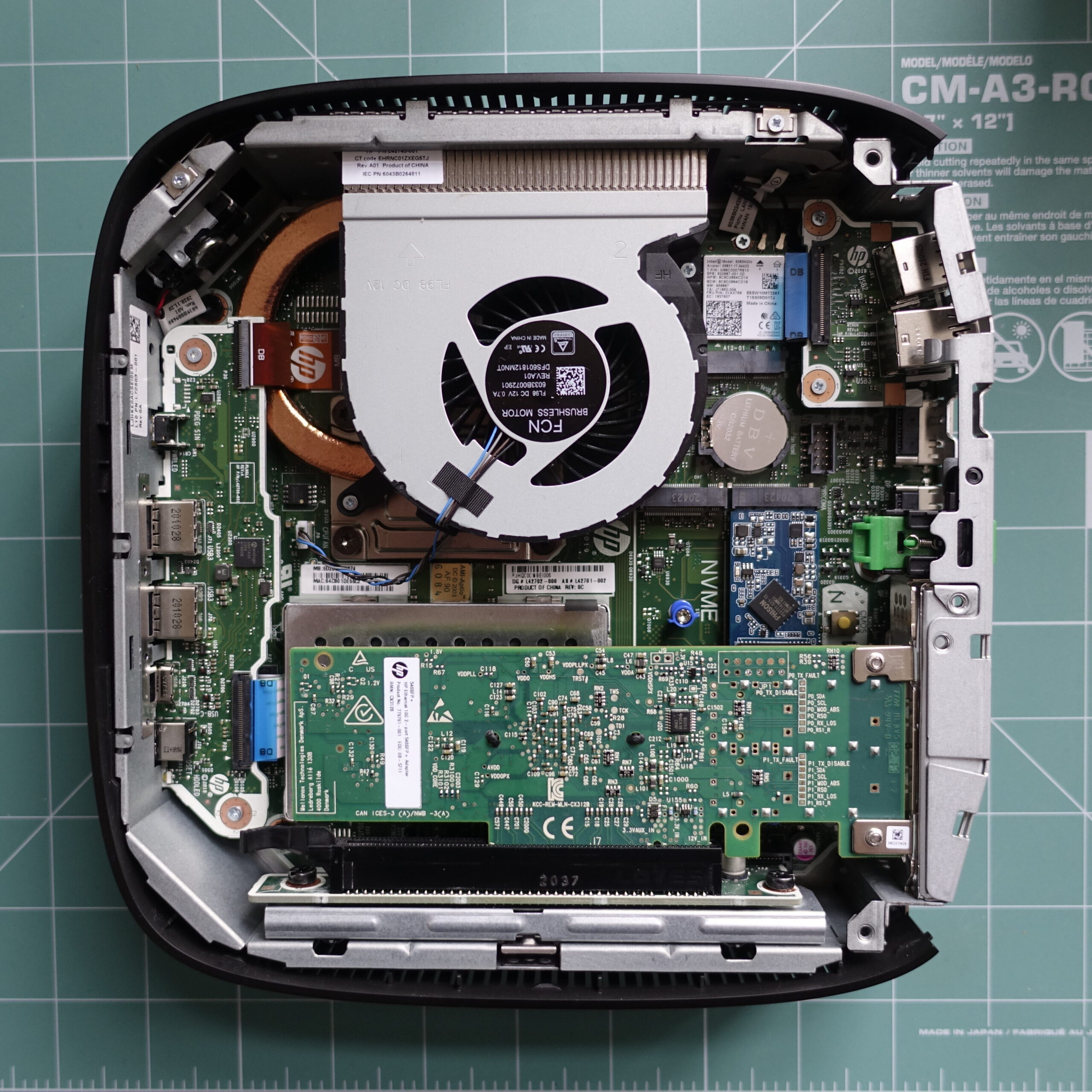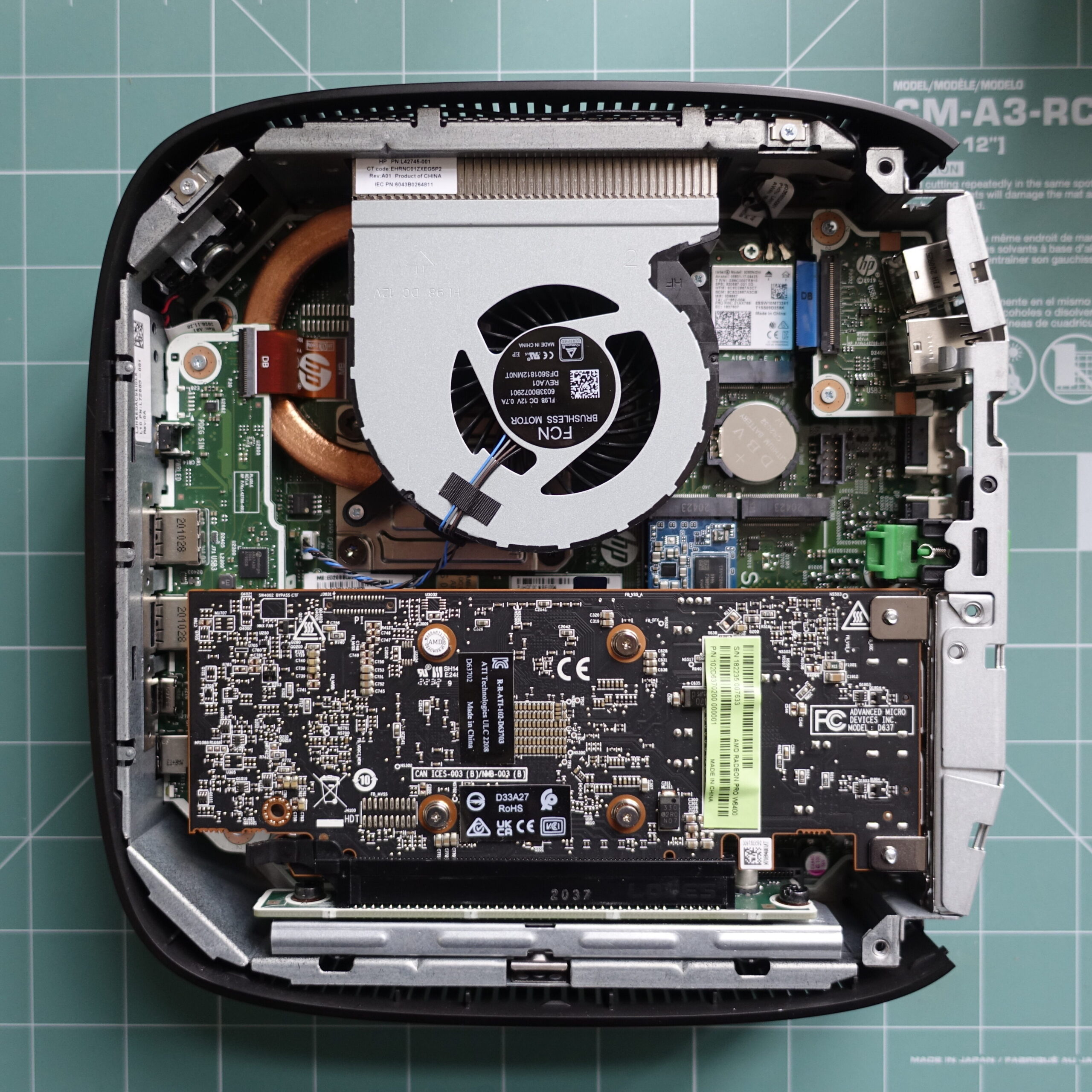Just like most homelabbers, I like mini PCs. They are cute, use very little power and are quiet, at least in idle and under light loads. The Intel NUCs were at the forefront of this revolution and it’s quite unfortunate that Intel has discontinued that division. The newer generations of Mini PCs seem to have somewhat more flexibilty using extra m.2 slots and proprietary expansion modules, but that’s usually it. No PCIe slots that would make them truly universal.
This is where HP’s T740 thin client differs.
The T740 is a thin client, at least on paper. It is the top-end model of their TX40 series and is aimed towards a very specific segment, which is graphics-intensive computing environments. It has four Display Port outputs for driving four 4K screens, which can optionally be increased to six, if one opts for a preinstalled AMD Radeon E9173 GPU that adds two more DPs. And this has already given away the secret, which is that it has a PCIe expansion slot. Yes. In a thin client.

That alone wouldn’t make it truly one of a kind, but in addition, it also boasts a quad-core AMD Zen-based CPU with up to 64GB of RAM. If HP were to put the same specs in one of their ProDesk desktops, it would fit right in with the rest of them. This is practically desktop level power.
- AMD Ryzen V1756B CPU, 3.25Ghz base, up to 3.6Ghz with Vega 8 iGPU
- Two DDR4 SODIMM slots for up to 64GB of RAM
- Two 2280 M-key M.2 slots, one for NVMe and one for SATA drives
- One 2230 E-key m.2 slot for a wireless card
The Ryzen V1756B is the embedded, soldered equivalent of the Ryzen 5 2400G, odenamed Great Horned Owl. It is a 14nm chip from Q1 of 2018, so while it isn’t exactly a recent chip, it still has decent performance.

The design looks very similar to HP’s other contemporary thin clients, and its BIOS copies their other thin clients as well, which shouldn’t be a surprise. However, we still get support for virtualization and some more advanced setup options.

I’ve had the opportunity to pick up three of them for a reasonable price and so I did. They were configured with 1x4GB RAM and 16GB of eMMC flash, which is a bit like the Steam Deck’s 64GB drive. It’s an NVMe drive, but it doesn’t come anywhere close to saturating those speeds and is actually slower than a SATA drive would be, it’s just using PCIe instead of SATA.
I ended up doing very different things with the three units. One became a pfSense box, another a mini gaming PC and the last one is just a HTPC, which doesn’t really utilize the PCIe slot. I actually had a T640 for that up until recently, so it essentially replaces that.
ServeTheHome has a great article on the T740, but I did find some conflicting info. They measured an idle power consumption in the 19-20W range, while I measured around 10-12W when booted into the factory ThinPro OS with BIOS v01.15 reset to defaults. This seems to be too big of a difference to be caused by variations in the testing equipment, so I think the power can be brought down to around 10W to be in line with most other thin clients. The fan seems to be always-on by default, I haven’t tried if it can be turned off in idle, but it’s completely inaudible, so it doesn’t really bother me. In fact, if there is a PCIe card installed, the extra airflow can be quite useful to ensure things don’t heat up too much in the inside.
The router
I’ve been using pfSense for a long time, but I’m certain that any other router OS would run great on this thing. I’ve added a Mellanox ConnectX-3 Pro NIC with two 10Gb SFP+ ports. I’m not entirely certain if the CPU is capable of routing 10Gb/s of traffic, as I haven’t had a chance to test it with such a high speed connection. If pfSense can’t do it, then TNSR should be able to. FreeBSD-based systems may need some tweaks to boot up, but that’s just a one-off setup.

I used a 128GB SATA drive with MLC flash to ensure it lasts and added 2x4GB of RAM, alongside the ConnectX-3. Te integrated gigabit ethernet controller is a Realtek 8111, which is not everyone’s favourite, but I’ve used a mini PC with two of them as a pfSense router with no issues whatsoever. I don’t know if 2.7.0 includes the drivers for them, or you still need to install them separately, but they do work, so that extra potr can be used for either local LAN access or for a second WAN connection. This config idles around 20W with no added optics or other SFP modules in the Mellanox NIC.
The HTPC
This is the simplest one, I just pulled the eMMC and replaced it with a 256GB NVMe drive. The integrated Vega 8 GPU is fast enough to handle some of the more taxing upscaling and sharpening filters in madVR and it can output a 24Hz signal as well for 24p Blu-ray playback. All of this in 4K, of course. Passive DP to HDMI adapters work well, as all four are DP++ ports, but those can only do 1080p. If you want to connect a 4K display, you need to use a DP cable or an active DP to HDMI 2.0 adapter.
The gaming PC
I know one wouldn’t normally think of a thin client as a platform to run games on. You might use it for streaming games to it, or maybe run some old retro titles locally, but that’s not my intention. I wanted to put together the fastest T740. That required the T740, of course, and an AMD W6400, which is currently the most power-efficient HHHL (half-height half-length) GPU. It’s about as fast as a 7970, which is another card I used to have a long time ago, except that easily pulled in 300W of power.

Along with the W6400, I installed 2x8GB of 3200Mhz DDR4 RAM and a 2TB NVMe SSD. There were some problems, however. The BIOS does not recognize the W6400 as a GPU, as that’s not what HP used to bundle with the device and therefore the option to use the external GPU for booting and showing the BIOS screens is simply not possible. However, that’s okay, Windows will happily output an image through the card’s connectors, once it’s booted. The other, more serious issue is with driver compatibility. I could not get two copies of the official AMD drivers installed and working at the same time. This is a problem, because the integrated GPU can’t be disabled and if the driver isn’t loaded properly, sleep doesn’t work and the iGPU pulls more power than necessary in idle, leaving less for the CPU cores. You see, one reason for using a dedicated GPU is the extra graphics power it adds, but another side effect is being able to leave the integrated GPU in idle, so that the CPU cores can utilize the power that would have otherwise been used up by the iGPU.
Of course, adding things up, the 45W TDP of the CPU and the 50W board power of the W6400 is already at 85W, which is dangerously close to the 90W rating of the external power supply. So it should be no surprise that this config was pulling 116W from the wall while playing Tomb Raider. Through the 90W PSU. And then it dropped down to 40-50W once the power supply’s built-in protection kicked in. Then back to 115W and again 50W. Don’t try this at home. I think I nearly killed that PSU. This was with the balanced power profile in Windows and the broken Vega 8 driver.
There is an unofficial third party AMD driver from Amernime Zone, which allowed me to install both the Vega 8 and W6400 drivers and have them working at the same time. With this combo, the idle power was at 22-23W in the power saver profile and 28W in the Ryzen Balanced profile, which was installed by the AMD chipset drivers.
But that’s not the interesting part. Even with the proper drivers, the balanced profile allowed the CPU to reach 3.6Ghz and use up to 115W during games and 3DMark. To counter this, using the power saver profile with the max CPU speed set to 99% helps to maximize the power consumption around 85W, which is perfect. We can happily draw up to 95W from the 90W PSU, so 85W is not an issue, even for extended periods. But how does this affect performance? Well, below are some scores ffrom a number of 3DMark runs that compare the balancedprofile with power saver, maximized at 99% CPU speeds.
| Fire Strike | Graphics | Physics | Combined | Overall |
| Balanced | 12077 | 10550 | 3055 | 9169 |
| Power Saver | 11962 | 7371 | 2790 | 8411 |
| delta | -1.0% | -30.0% | -8.7% | -8.3% |
In Fire Strike, the physics scores are most affected, which is expected, as that’s the most CPU-bound test. The overall score only went down by 8.3%, which is not a very significant difference.
| Time Spy | Graphics | CPU | Overall |
| Balanced | 3357 | 3209 | 3333 |
| Power Saver | 3499 | 2434 | 3283 |
| delta | +4.2% | -24.2% | -1.5% |
Time Spy looks a bit different, as the graphics scores went up a bit, this is because that test pulls the most power and it triggered the PSU’s overcurrent protection multiple times during the test, causing the GPU to drop many frames. The difference in CPU performance is similar, but the overall score only went down by 1.5%, which is barely noticeable.
A larger PSU could probably help, but I don’t know how much thermal load the chassis could safely dissipate. 85W is probably okay, but 115-120W may be too much.
I would like to note here that despite the insufficient PSU, I had no issues with installing a graphics card whatsoever. Some people reported that their T740 didn’t turn on with an RX6400 installed1 and I also found some suggestions2 that the voltage regulator supplying the PCIe slot is only rated at 3A at 12V, which woudl maximize its capacity at 36W.
I think I managed to invalidate both of these claims, but I do not suggest that either of these statemets are false. There may be BIOS or hardware revisions that refuse to boot with an RX6400 and there may also be hardware revisions which are indeed limited to supplying 36W to the PCIe card.
Closing thoughts
I think the T740 is a great and incredibly versatile mini PC. Thanks to the potent CPU, iGPU and PCIe expansion slot, the possibilities are endless. It’s also a very low power platform. Thanks to the soldered CPU and lack of chipset, the idle power without an expansion card is around 10W and the lack of chipset doesn’t really come with any disadvanteges here. We still get two 10G and two 5G USB3 ports and three USB2s, which should be more than enough for most use cases. All of this coupled with full-fledged virtualization capabilities make this a great all-around box that can handle anything.
But as with everything there are a few negatives as well. First of all, the fan. It never stops. And while some extra airflow is a good think if you have an expansion card installed, it would be nice to have an entirely passive mode when the system is idling, simply to reduce the amount of dust it sucks in.
The power supply may also be an issue if a dedicated GPU is installed, but a 120W model can be had for £20, if needed. Although I would be a bit worried about the chassis’ ability to dissipate that much heat.
And speaking of heat, the CPU fan, which is the only fan in the machine is controlled by the CPU temperature. If the expansion card heats up, then tough luck, the CPU fan won’t go any faster and that heat will be trapped inside the case. If you play games and evenly load the GPU and the CPU, then this shouldn’t be a problem, because the load on the CPU will speed up the fan, which will exhaust the heat generated by the GPU as well. The original card that was bundled with the system had a blower-style cooler, which directed most of the heat it generated straight out of the system through the backplate, which solved the issue, but I couldn’t find an RX6400 like that and the W6400 only comes in a single AMD variant.
By the way, I think that AMD variant is actually the best one of all of the low-profile designs of Navi 24, as it actually includes a copper heatpipe that spreads out the heat along the full length of the heatsink, whereas I couldn’t see that on any of the RX6400 cards. The downside is that AMD didn’t allow zero RPM mode on the W6400, so even if there is no load, the fan will run at a very low RPM. This is inaudible, but it will increase the dust buildup on the heatsink.
Leave a Reply